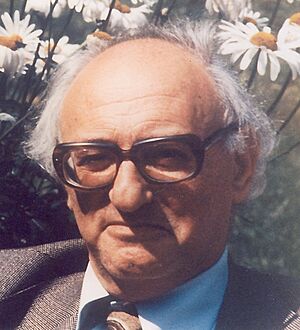Henri van Praag facts for kids
Quick facts for kids
Henri van Praag
|
|
|---|---|
 |
|
| Born |
Naphthali ben Levi van Praag
12 September 1916 Amsterdam, Netherlands
|
| Died | 3 November 1988 (aged 72) |
| Nationality | Dutch |
| Occupation | Educator, philosopher |
Naphthali ben Levi (Henri) van Praag (born September 12, 1916, in Amsterdam – died November 3, 1988, in Hilversum) was a Jewish-Dutch writer, teacher, and historian of religions. He also became well-known for his writings about parapsychology, which explores unexplained mental abilities.
Contents
Childhood and Learning
Henri van Praag grew up in a Jewish family, though they were not very religious. His father, Louis van Praag, was a diamond cutter. The family moved to Antwerp, Belgium, where Henri went to elementary and high school.
In 1931, his family moved back to Amsterdam. Henri attended a municipal training college and earned his diploma in 1936. There, he met Leny van Huystee, whom he later married in 1947. He also earned certificates to become a headmaster and a French teacher.
During this time, Henri became very interested in mysticism, which is about spiritual truths and hidden meanings. He read works by Chinese thinkers, Jewish mystics, and philosophers like Dr. Philip Kohnstamm. He also worked as a psychologist and psychotherapist, helping people with their thoughts and feelings.
Henri van Praag spent World War II in hiding to escape danger. Many of his relatives were sent to concentration camps, where more than seventy family members were sadly killed. Leny stayed in touch with him during this difficult period.
After the War
After the war, Henri van Praag wanted to work for peace. He aimed to connect with people from all religions and cultures. He shared information about many different beliefs, from Judaism to Buddhism, and from science to spiritual ideas.
He continued his education, studying many subjects at university. These included philosophy, physics, education, logic, mathematics, and psychology. He also studied Judaica, which is about Jewish history and culture.
Henri was very involved with Jewish children who returned from the camps. He also did research for the Institute for the Tropics. His first book, The Meaning of Education (1950), was about teaching and learning. He earned his bachelor's degree in 1950 and his master's degree in 1951. He also wrote a novel under the name Bernard Raimond, which showed his interest in China, Jewish mysticism, and reincarnation.
In 1946, Henri van Praag became a director at a teaching school. He also worked at the Dutch Institute for Psychological Research. In 1949, he attended a philosophy conference in Paris. By 1951, he was a consultant for a social consulting institute.
In 1952, Henri became chairman of the World Organization for Mutual Understanding and Co-operation (WOMUC). This group aimed to bring people together. Otto Frank, Anne Frank's father, was also involved. They planned a series of books about religious writings, but the project changed due to unforeseen events.
Time in Uruguay (1953-1954)
In the early 1950s, the Soviet Union under Joseph Stalin began to treat Jewish people unfairly. In 1953, Henri van Praag went to Uruguay in South America. He wanted to see if Uruguay could be a new home for Jewish children.
While in Montevideo, he taught psychology, education, and philosophy. He also continued his work as a psychologist-therapist, offering advice and support to people. He studied Chinese language and culture with Professor Li Yu-Ying.
The situation for Jewish people in Russia began to improve after Stalin's death in 1953. Because of this, the mission to find a new home for children in South America was no longer needed.
Active in Society (1954-1973)
In 1954, Henri van Praag helped start an organization with his brother. Its goal was to improve the conversation and understanding between Jewish people and Christians. He also worked on a series of books called Phoenix Bible Paperbacks. This project involved new translations of the Old Testament from Hebrew into Dutch. Henri wrote many articles and connecting texts for this series. These were based on many discussions between Protestants, Catholics, Jews, and some Muslims.
Henri van Praag was involved in many different areas. In 1957, he became a teacher of education at a local college. He also became a professor at the LOI (Pelman Institute). In 1958, he became director of a center for educational psychology in Amsterdam. From 1966, he was a senior lecturer for Teleac, an educational broadcaster. He was also an editor for various publishers and magazines. He was a respected partner for important people in science, religion, politics, and philosophy.
As a Professor (1973-1988)
From 1973 to 1978, Henri van Praag was a professor of sociology at the Wageningen Agricultural University. In 1974, he helped establish the International Academy of Manternach in Luxembourg. This academy later became the International University Lugano in Switzerland in 1979. Henri van Praag served as Chancellor there and taught psychology and parapsychology. He was also the rector (head) of the Academy of Religion Vergleichende Geschichte in Duisburg, Germany, where he taught religious studies.
In 1975, he started the magazine Prana, which focused on spirituality and the edges of science. He had a good relationship with the publisher, Paul Kluwer, and advised him.
In 1978, he took over as professor of parapsychology at the University of Utrecht. He held this position until 1986. Henri van Praag believed that parapsychology should be seen as a border area of psychology. He compared it to how Albert Einstein described a straight line as a curve with zero curvature, meaning it's a special case of a broader idea.
His wife, Leny van Praag - Van Huystee, passed away in 1981.

